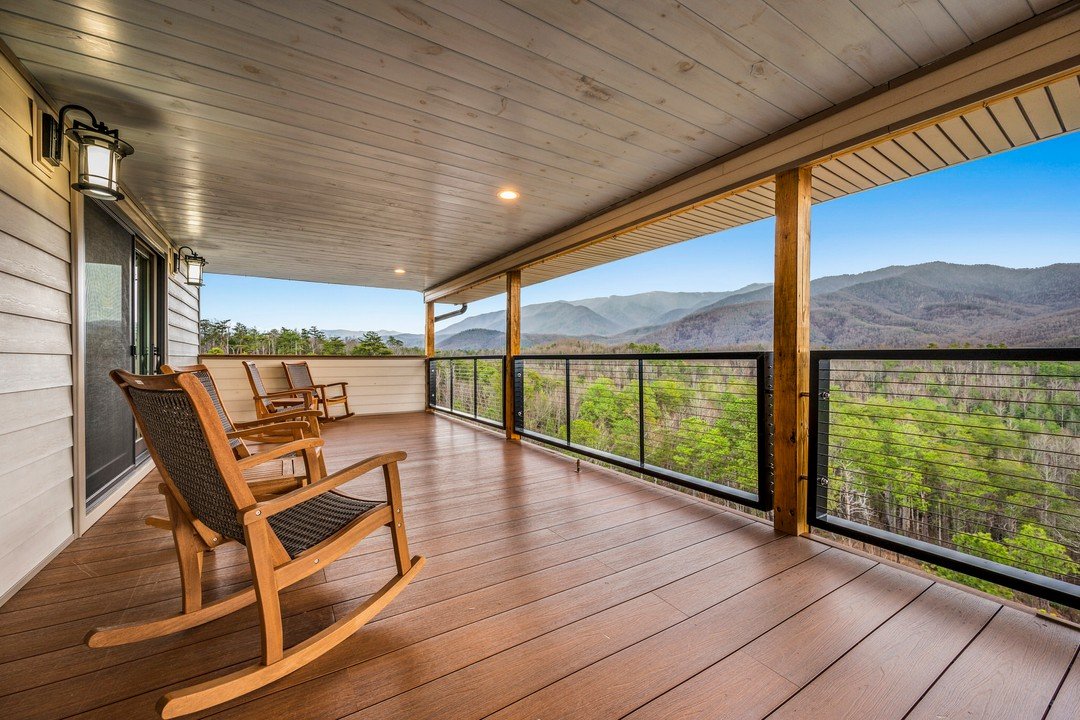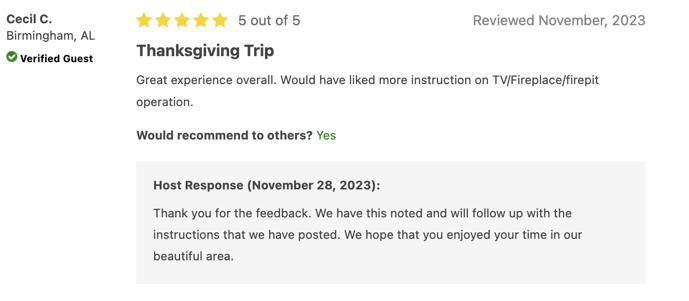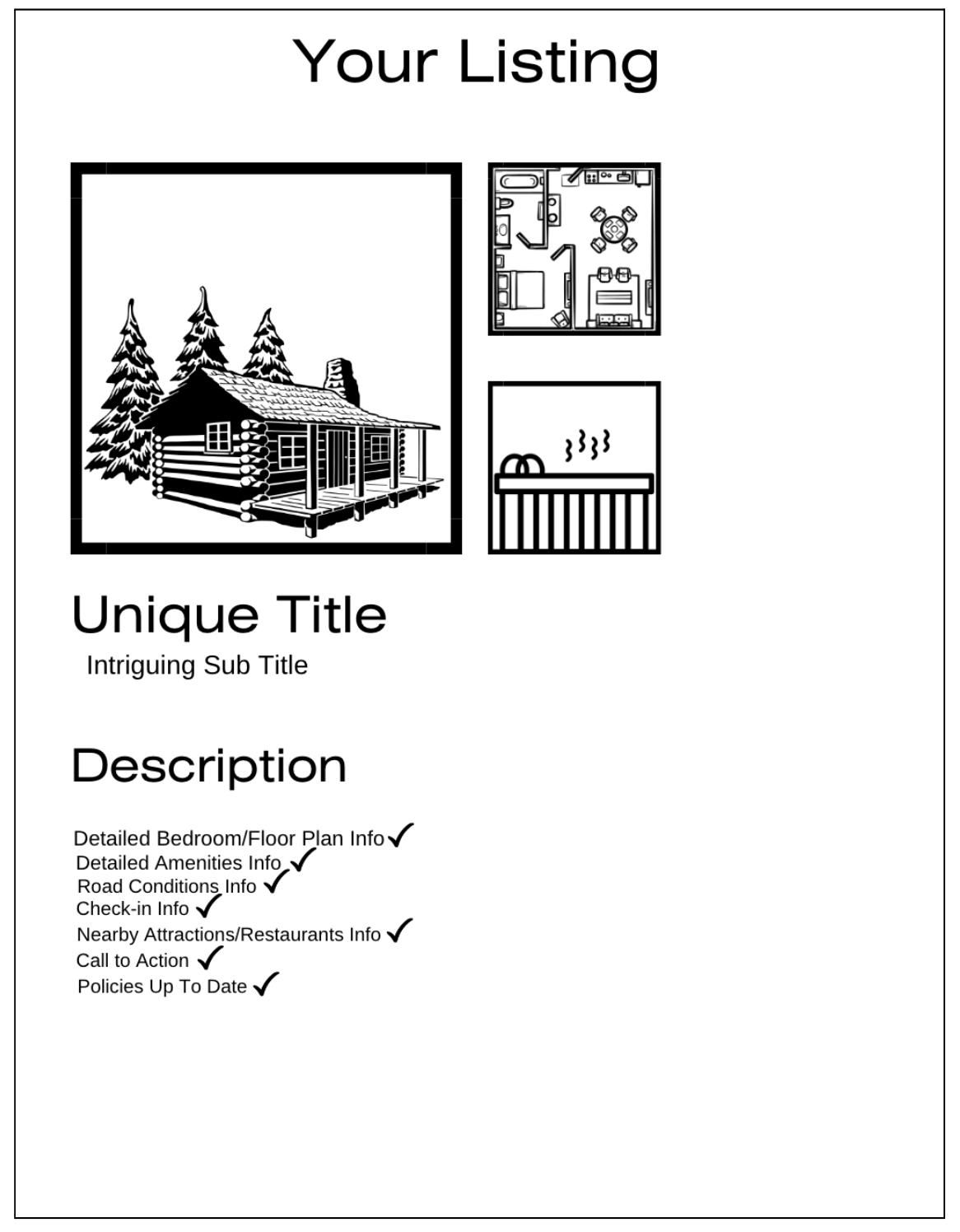The Anatomy of a Vacation Rental Listing
A property's first impression is often made through a carefully crafted listing page. From the name of the property, to the description, to the images, everything must be considered thoroughly in order to gain the attraction of the right guests.
Whether you're a seasoned property manager or just starting your journey in the vacation rental industry (welcome to the fun!), knowing the key elements of what makes a listing most valuable will be beneficial to both yourselves and your potential customers.
Table of Contents:
● Crafting the Perfect Title for Your Property
● Taking Photos of Your Property
● Making a Helpful Description
● Including the Right Information in Your Policies
● How Reviews Can Help
● Highlighting the “Call to Action”
Top 10 Questions Guests Should Have Answered On Your Listing Page:
What does the property currently look like?
What is the floor plan layout of the home?
What does each bedroom sleep and what type of beds are in them?
What special amenities does it offer?
How many cars can park in the parking spot or driveway?
What are the roads like leading up to the home? Are they steep?
What restaurants or attractions are nearby?
If it’s pet-friendly, what are the restrictions and what is the fee?
What is the cancellation policy?
What have recent visits been like? Did they address any issues? (Reviews)
Crafting the Perfect Title for Your Property
Let’s start from the beginning... We’ve seen some clever vacation rental names over the years, but we also know that picking a name can be a bit overwhelming at first. If you don’t have one that immediately comes to you, then there are a few ways of going about creating one that properly suits your listing.
If your property has an incredible amenity that travelers will appreciate, come up with a punny or interesting way to include it in the name!
Sugar Paws: A Pet-Friendly Rental
Sea-Clusion: A Rental with Sea Views
Splish-N-Splash: A Cabin with an Indoor Pool
2. Try to navigate away from choosing a plain title OR a title that is frequently overused.
Vacation rentals in certain markets can be oversaturated. This means that a lot of rentals end up having the same name or extremely similar names. *Multiple same-name options can cause confusion for end-users. You want to stray away from the possibility of travelers typing in the name of your listing on Google only to end up with a completely different rental.
Complement the Title with a Thought-Out Sub-Title
It’s important to highlight the most important features of your property in this sub-title as it is one of the first things that a potential customer will see. Does your property include a special discount or a unique selling point? Include that in your sub title! *If your rental comes with free tickets to attractions, beach chairs and beach service, or private access to a trail or a beach, these are all things we would typically include in a sub-title.
Taking Photos of Your Property
You can display some incredible photos of your properties if you know the correct angles and what to photograph….
Make sure to capture photos of all amenities
Customers love to look at pictures of specific amenities.. If your description mentions an indoor pool, but the pictures don’t feature the indoor pool, customers will begin to question the condition of the indoor pool (or if there is no pool at all)..
2. If your property features a specialty function like accessibility, include accessible features in photos.
If you are labeling your property as accessible and wheelchair-friendly, then it’s important to take photos of all of the features that are accessible so that customers can have a better understanding of how accessible it truly is. For example, if you have a ramp leading up to the front steps or if you have an elevator, include pictures of these. Another popular question is if a property has the right accessible showers or tubs.
3. If you hire someone or if you take the photos yourself, make sure that you take the right angles.
Marketing your property is largely about using angles to your advantage. The different angles to your photos should never be slanted, but should always provide a general consensus to what the customers would see and feel if they rented your property. Try to angle in various ways to give a complete overview of each room.
4. A picture you should definitely include: floor plans.
Customers love to look at floor plans, especially if the description doesn’t include any information about the different rooms in detail. Including a floor plan is a helpful way of detailing each level and each room.
5. Although the driveway may not be an amenity, take a picture of it…
Of course, we don’t necessarily always think to take a picture of the driveway, but groups that travel love to know what the parking situation will be like. How many cars can the driveway fit and how steep is the driveway? Including a photo of the parking situation will help them see how many cars to bring and how to best navigate who brings a car (or RV)
6. While mountain views or beachfront photos are great to include in your photo selection, the first photo/preview image of your property should include either an interior or exterior picture of your property…
At the end of the day, we want customers to click on our properties in any search, but it’s a little harder to get customers to click on photos that don’t show what the property looks like. We recommend saving the preview image for an interior or exterior property photo, and then include these other amenity/nature photos as additional images.
7. If you manage multiple properties, make sure that you use different images for each so that customers don’t think that they are the same property.
It does make it easier when you can use the same photos for properties that you manage, but it causes major confusion when customers see two or more exact same images for different properties.
8. Finally, if your photos are blurry, outdated, dark, or sized improperly, take new ones.
If guests see a blurry, dark, or outdated image, then they might think that you don’t care enough to take new photos, nothing has been updated, which means you may not care about the rental at all. While we know this is definitely not the case, it does matter to the customers. *Rule of thumb is to always update your photos if any changes are done, and to update them if they look a little older and fuzzy.
Making a Helpful Description: Your Description is Important!
Having a helpful description is one of the most important features of a property listing page (besides the photos). In this section, we will go step by step with examples of the important things to include in these descriptions, customer questions, and how best to include and layout this information within your description…
1. Comprehensive Floor by Floor and Bedroom by Bedroom Details:
A highly valuable detail for customers is which floor each of the bedrooms are on, what are the beds that each bedroom has, and which respected bedrooms have the bathrooms. We mentioned this earlier when discussing photos, but this amount of detail is especially important for those who need a more accessible cabin.
2. Amenity Information: How Much Information Do They Need?
We are all aware of how much amenities can make or break a vacation experience. Make sure that you touch base on each individual amenity. If it has a unique feature, include that as well.
3. Road Conditions Leading Up to the Rental *Seasonality & Area-Specific
If you are in a market with winding roads or a market that has extreme seasonality changes (snow), then it is important to include information about the nearby roads. Are the roads leading to the rental steep? Are they high off the main road? Do they tend to get icy and dangerous fairly quickly?
4. Checkin Process:
While we do state our checkin policies and checkout rules, if you do something a little bit different then it’s best to put it at the end of your description. We understand that some owners/managers like to meet the guests staying at their rental and others like to proceed without face-to-face contact.
While this isn’t a necessary change that you need to make, it could have some added benefit for end-users to know exactly what type of check-in they are getting before they book.
5. List the Nearby Attractions and Restaurants:
Travelers love to book their vacation rentals or cabins near popular attractions and restaurants. If your property is near a knowingly popular shop, eatery, or attraction, then include it in your description!
Including the Right Information in Your Policies
Policies are an important part of booking your listing. Make sure that, beforehand, you have given all necessary information when it comes to your properties.
If you have a pet-friendly policy, make sure that you include these key factors:
General Pet Policy
Pet Fee Price (Per Pet)
Pet Restrictions (Weight Limit & Breed Restrictions)
When it comes to your cancellation policy, simply make sure that it is stated exactly how you want it and is up to date.
How Reviews Can Help…
Getting reviews can be hard, but if and when you do, they are pivotal factors in the booking process. After a guest’s stay, send them an email and ask them to leave a review. It will help other guests get a better picture of what it is like to stay at your property.
Highlighting the “Call to Action”
It’s always helpful to include a more personalized call-to-action in the description enticing travelers to book.
Now that we’ve overloaded you with information, tips, and tricks, if you have any personalized questions about your property listing page, feel free to contact us. We hope this inspires you to try new techniques and ultimately provide more value to the potential bookers of your property!






















